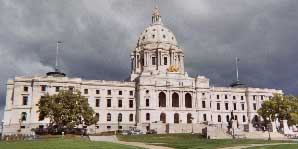Minnesota State Capitol
|
|
The Minnesota State Capitol is located in Minnesota's capital city, Saint Paul, and houses the Minnesota Senate, Minnesota House of Representatives, the Office of the Attorney General and the Office of the Governor. The building also includes a chamber for the Minnesota Supreme Court, although court activities usually take place in the next-door Minnesota Judicial Center. The building was designed by Cass Gilbert and modeled after Saint Peter's Basilica in Rome. It is believed to be one of just four or five buildings in the world with an unsupported marble dome. This one is the second-largest of the group. Work began in on the capitol in 1896, and construction was completed in 1905. It is the third building to serve this purpose: the first capitol was destroyed by fire in 1881, and the second was completed in 1883, but was considered to be too small almost immediately.
Above the southern entrance to the building is a gilded quadriga called Progress of the State which was sculpted by Daniel Chester French and Edward Clark Potter. It was completed and raised to the roof of the capitol in 1906. In 1994 and 1995, the statues underwent a restoration procedure which included replacing the gold leaf on the figures. A ball perched above the capitol dome also has similar treatment.
StPetersDome.jpg
Any classical dome built since Michelangelo's must expect to be compared to it, and Gilbert's dome is a frank homage, with interesting differences. His drawings show that he originally planned a wider drum and, correspondingly, a more massive dome. The smaller dome as built could be criticized by some as too small. It is smaller than St. Peter's and has a simplified design: single columns round the lantern instead of double ones, for instance. The ribs on the capitol dome are less apparent than those on St. Peter's, but they are still visually apparent. Gilbert knew that St. Peter's dome was on the edge of being unstable: it had cracked and had to be reinforced. His engineer for this project, Gunvald Aus, bound the brick dome in reinforcing steel bands, and Gilbert crowned the paired columns round the drum (which act as buttresses to counter the dome's weight) with additional stone. Other than St. Peter's, additional buildings with marble domes include the Taj Mahal in India, and the Rhode Island State House in the city of Providence.
Progress_of_the_State_quadriga.jpg
The central block under the dome needed three entrances, and Gilbert avoided creating visual references to a triumphal arch, which would have been inappropriate in the position. Equally, he managed to avoid any reference to a palace block that would have been offensive to Minnesotans. However, Gilbert drew ire for choosing stone from Georgia rather than native Minnesota stone. A compromise was eventually made where the base of the building and interior spaces used varieties of native stone. Upon completion, the exterior and interior of the building drew praise, leading to requests for Gilbert to design capitol buildings for other states such as West Virginia and Arkansas and other notable structures.
The capitol cost US$4.5 million back at the beginning of the 20th century. It opened its doors to the public for the first time on January 2, 1905. A hundred years later, the building's estimated value is $400 million. As part of the capitol's centennial celebrations in 2005, lawmakers hope to gain support for and donations toward a proposed $65 million renovation project.
The structure was added to the National Register of Historic Places in 1972.
See also
External link
- Gilbert sketch for the project (http://architecture.about.com/library/blgilbertsminnesota.htm)
References
- Charles Campbell (2004). The Minnesota State Capitol. (http://mncontent.com/features/feature.idc?LoginID=debg)

